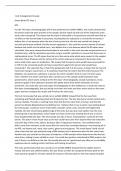Essay
Assignment 2 resubmission Unit 4 - Forensic Investigation Procedures in Practice
- Institution
- PEARSON (PEARSON)
This document secures the merit criteria surrounding testing results and what they mean. This document may be helpful for those unsure on how to write or word this criteria.
[Show more]



